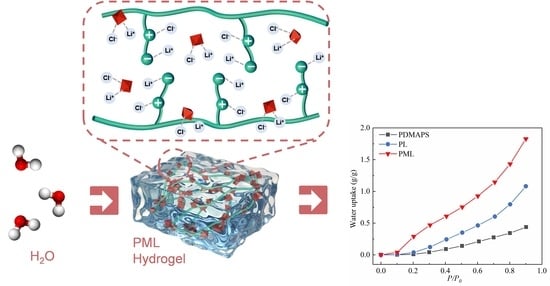A Polyzwitterionic@MOF Hydrogel with Exceptionally High Water Vapor Uptake for Efficient Atmospheric Water Harvesting
Abstract
:1. Introduction
2. Results and Discussion
2.1. Swelling Properties
2.2. XRD Analysis
2.3. SEM Analysis
2.4. FTIR Analysis
2.5. Thermogravimetric Analysis
2.6. Adsorption Isotherms of Water Vapor on the PL with Different LiCl Content
2.7. Adsorption Isotherms of Water Vapor on the PDMAPS, PL, PML Hydrogels, and MIL-101(Cr)/LiCl
2.8. Adsorption Kinetics of Water Vapor on the PDMAPS, PL, PML Hydrogels
2.9. Desorption Kinetics of Water Vapor on the PML Hydrogel
2.10. Multiple Adsorption-Desorption Cycles of Water Vapor on the PML Hydrogel
3. Materials and Methods
3.1. Synthesis
3.2. Characterization
3.3. Adsorption of Water Vapor
3.4. Calculation of the Swelling Ratio
4. Conclusions
Supplementary Materials
Author Contributions
Funding
Institutional Review Board Statement
Informed Consent Statement
Data Availability Statement
Conflicts of Interest
References
- Hanikel, N.; Prévot, M.S.; Yaghi, O.M. MOF water harvesters. Nat. Nanotechnol. 2020, 15, 348–355. [Google Scholar] [CrossRef] [PubMed]
- The Sustainable Development Goals Report 2022. Available online: https://unstats.un.org/sdgs/report/2022/ (accessed on 7 July 2022).
- Gleick, P. Water in Crisis: A Guide to the World’s Fresh Water Resources; Oxford University Press: New York, NY, USA, 1993; pp. 13–24. [Google Scholar]
- Zhang, C.; Guo, H.; Li, C.; Wang, F.; Guo, X.; Li, A.; Gong, S.; Zhang, H.; Zhang, X.; Qin, X. Atmospheric water extraction—A review from materials to devices. J. Mater. Chem. A. 2023, 11, 22041–22057. [Google Scholar] [CrossRef]
- Gordeeva, L.G.; Solovyeva, M.V.; Sapienza, A.; Aristov, Y.I. Potable water extraction from the atmosphere: Potential of MOFs. Renew. Energy 2020, 148, 72–80. [Google Scholar] [CrossRef]
- Gado, M.G.; Nasser, M.; Hassan, A.A.; Hassan, H. Adsorption-based atmospheric water harvesting powered by solar energy: Comprehensive review on desiccant materials and systems. Process Saf. Environ. Prot. 2022, 160, 166–183. [Google Scholar] [CrossRef]
- Kim, H.; Rao, S.R.; Kapustin, E.A.; Zhao, L.; Yang, S.; Yaghi, O.M.; Wang, E.N. Adsorption-based atmospheric water harvesting device for arid climates. Nat. Commun. 2018, 9, 1191. [Google Scholar] [CrossRef] [PubMed]
- Asim, N.; Badiei, M.; Alghoul, M.A.; Mohammad, M.; Samsudin, N.A.; Amin, N.; Sopian, K. Sorbent-based air water-harvesting systems: Progress, limitation, and consideration. Rev. Environ. Sci. Bio/Technol. 2021, 20, 257–279. [Google Scholar] [CrossRef]
- Mouchaham, G.; Cui, F.S.; Nouar, F.; Pimenta, V.; Chang, J.S.; Serre, C. Metal-organic frameworks and water: ‘From old enemies to friends’? Trends Chem. 2020, 2, 990–1003. [Google Scholar] [CrossRef]
- Xu, W.; Yaghi, O.M. Metal-organic frameworks for water harvesting from air, anywhere, anytime. ACS Cent. Sci. 2020, 6, 1348–1354. [Google Scholar] [CrossRef] [PubMed]
- Yu, N.; Wang, R.; Lu, Z.; Wang, L.; Ishugah, T.F. Evaluation of a three-phase sorption cycle for thermal energy storage. Energy 2014, 67, 468–478. [Google Scholar] [CrossRef]
- Wang, X.; Li, X.; Liu, G.; Li, J.; Hu, X.; Xu, N.; Zhao, W.; Zhu, B.; Zhu, J. An interfacial solar heating assisted liquid sorbent atmospheric water generator. Angew. Chem. Int. Ed. 2019, 58, 12054–12058. [Google Scholar] [CrossRef] [PubMed]
- Li, N.; Li, X.; Zhang, T.; Qiu, S.; Zhu, G.; Zheng, W.; Yu, W. Host-guest composite materials of LiCl/NaY with wide range of humidity sensitivity. Mater. Lett. 2004, 58, 1535–1539. [Google Scholar] [CrossRef]
- Srivastava, N.C.; Eames, I.W. A review of adsorbents and adsorbates in solid-vapour adsorption heat pump systems. Appl. Therm. Eng. 1998, 18, 707–714. [Google Scholar] [CrossRef]
- Ng, E.-P.; Mintova, S. Nanoporous materials with enhanced hydrophilicity and high water sorption capacity. Microporous Mesoporous Mater. 2008, 114, 1–26. [Google Scholar] [CrossRef]
- Yu, N.; Wang, R.; Lu, Z.; Wang, L. Development and characterization of silica gel-LiCl composite sorbents for thermal energy storage. Chem. Eng. Sci. 2014, 111, 73–84. [Google Scholar] [CrossRef]
- Wu, H.; Xiong, Y.; Yu, D.; Yang, P.; Shi, H.; Huang, L.; Wu, Y.; Xi, M.; Xiao, P.; Yang, L. Fe-Co controlled super-hygroscopic hydrogels toward efficient atmospheric water harvesting. Nanoscale 2022, 14, 18022–18032. [Google Scholar] [CrossRef] [PubMed]
- Zhao, J.; Xiong, Y.; Wu, M.; Xi, M.; Liu, H.; Guo, S.; Yang, L.; Tan, S. A Hydroscopic indium hydrogel capturing atmospheric humidity for autonomous agriculture. Sol. RRL 2023, 7, 2300414. [Google Scholar] [CrossRef]
- Yang, K.; Pan, T.; Pinnau, I.; Shi, Z.; Han, Y. Simultaneous generation of atmospheric water and electricity using a hygroscopic aerogel with fast sorption kinetics. Nano Energy 2020, 78, 105326. [Google Scholar] [CrossRef]
- Zhao, H.; Wang, Z.; Li, Q.; Wu, T.; Zhang, M.; Shi, Q. Water sorption on composite material “zeolite 13X modified by LiCl and CaCl2”. Microporous Mesoporous Mater. 2020, 299, 110109. [Google Scholar] [CrossRef]
- Teo, H.; Chakraborty, A.; Fan, W. Improved adsorption characteristics data for AQSOA types zeolites and water systems under static and dynamic conditions. Microporous Mesoporous Mater. 2017, 242, 109–117. [Google Scholar]
- Li, R.; Shi, Y.; Wu, M.; Hong, S.; Wang, P. Improving atmospheric water production yield: Enabling multiple water harvesting cycles with nano sorbent. Nano Energy 2020, 67, 104255. [Google Scholar] [CrossRef]
- Permyakova, A.; Wang, S.; Courbon, E.; Nouar, F.; Heymans, N.; D’Ans, P.; Barrier, N.; Billemont, P.; Weireld, G.D.; Steunou, N.; et al. Design of salt-metal organic framework composites for seasonal heat storage applications. J. Mater. Chem. A 2017, 5, 12889–12898. [Google Scholar] [CrossRef]
- Xu, J.; Li, T.; Chao, J.; Wu, S.; Yan, T.; Li, W.; Cao, B.; Wang, R. Efficient solar-driven water harvesting from arid air with metal-organic frameworks modified by hygroscopic salt. Angew. Chem. Int. Ed. 2020, 132, 5202–5210. [Google Scholar] [CrossRef] [PubMed]
- Schweng, P.; Mayer, F.; Galehdari, D.; Weiland, K.; Woodward, R. A Robust and Low-Cost Sulfonated Hypercrosslinked Polymer for Atmospheric Water Harvesting. Small 2023, 19, 2304562. [Google Scholar] [CrossRef] [PubMed]
- Byun, Y.; Coskun, A. Epoxy-Functionalized Porous Organic Polymers via the Diels-Alder Cycloaddition Reaction for Atmospheric Water Capture. Angew. Chem. Int. Ed. 2018, 57, 3173–3177. [Google Scholar] [CrossRef] [PubMed]
- Nguyen, H.; Hanikel, N.; Lyle, S.; Zhu, C.; Proserpio, D.; Yaghi, O.M. A Porous Covalent Organic Framework with Voided Square Grid Topology for Atmospheric Water Harvesting. J. Am. Chem. Soc. 2020, 142, 2218–2221. [Google Scholar] [CrossRef] [PubMed]
- Nguyen, H.; Gropp, C.; Hanikel, N.; Möckel, A.; Lund, A.; Yaghi, O.M. Hydrazine-Hydrazide-Linked Covalent Organic Frameworks for Water Harvesting. ACS Cent. Sci. 2022, 8, 926–932. [Google Scholar] [CrossRef] [PubMed]
- Chen, L.; Han, W.; Yan, X.; Zhang, J.; Jiang, Y.; Gu, Z. A Highly Stable Ortho-Ketoenamine Covalent Organic Framework with Balanced Hydrophilic and Hydrophobic Sites for Atmospheric Water Harvesting. ChemSusChem 2022, 15, e202201824. [Google Scholar] [CrossRef] [PubMed]
- Aleid, S.; Wu, M.; Li, R.; Wang, W. Salting-in effect of zwitterionic polymer hydrogel facilitates atmospheric water harvesting. ACS Mater. Lett. 2022, 4, 511–520. [Google Scholar] [CrossRef]
- Dong, D.; Tsao, C.; Hung, H.C.; Yao, F.; Tang, C.; Niu, L.; Ma, J.; MacArthur, J.; Sinclair, A.; Wu, K.; et al. High-strength and fibrous capsule-resistant zwitterionic elastomers. Sci. Adv. 2021, 7, 5442. [Google Scholar] [CrossRef]
- Guo, Y.; Bae, J.; Fang, Z.; Li, P.; Zhao, F.; Yu, G. Hydrogels and hydrogel-derived materials for energy and water sustainability. Chem. Rev. 2020, 120, 7642–7707. [Google Scholar] [CrossRef] [PubMed]
- Li, R.; Shi, Y.; Alsaedi, M.; Wu, M.; Shi, L.; Wang, P. Hybrid hydrogel with high water vapor harvesting capacity for deployable solar-driven atmospheric water generator. Environ. Sci. Technol. 2018, 52, 11367–11377. [Google Scholar] [CrossRef] [PubMed]
- Zhao, F.; Zhou, X.; Liu, Y.; Shi, Y.; Dai, Y.; Yu, G. Super Moisture-absorbent gels for all-weather atmospheric water harvesting. Adv. Mater. 2019, 31, 1806446. [Google Scholar] [CrossRef] [PubMed]
- Yang, C.; Wu, H.; Yun, J.; Jin, J.; Meng, H.; Caro, J.; Mi, J. Engineering of defective MOF-801 nanostructures within macroporous spheres for highly efficient and stable water harvesting. Adv. Mater. 2023, 35, 2210235. [Google Scholar] [CrossRef] [PubMed]
- Karmakar, A.; Mileo, P.G.M.; Bok, I.; Peh, S.B.; Zhang, J.; Yuan, H.; Maurin, G.; Zhao, D. Thermo-responsive MOF/polymer composites for temperature-mediated water capture and release. Angew. Chem. Int. Ed. 2020, 59, 11003–11009. [Google Scholar] [CrossRef]
- Yilmaz, G.; Meng, F.L.; Lu, W.; Abed, J.; Peh, C.K.N.; Gao, M.; Sargent, E.H.; Ho, G.W. Autonomous atmospheric water seeping MOF matrix. Sci. Adv. 2020, 6, 8605. [Google Scholar] [CrossRef] [PubMed]
- Xu, J.; Li, T.; Yan, T.; Wu, S.; Wu, M.; Chao, J.; Huo, X.; Wang, P.; Wang, R. Ultrahigh solar-driven atmospheric water production enabled by scalable rapid-cycling water harvester with vertically aligned nanocomposite sorbent. Energy Environ. Sci. 2021, 14, 5979–5994. [Google Scholar] [CrossRef]
- Yao, H.; Zhang, P.; Huang, Y.; Cheng, H.; Li, C.; Qu, L. Highly efficient clean water production from contaminated air with a wide humidity range. Adv. Mater. 2020, 32, 1905875. [Google Scholar] [CrossRef] [PubMed]
- Lei, C.; Guan, W.; Guo, Y.; Shi, W.; Wang, Y.; Johnston, K.P.; Yu, G. Polyzwitterionic hydrogels for highly efficient high salinity solar desalination. Angew. Chem. Int. Ed. 2022, 61, 202208487. [Google Scholar] [CrossRef] [PubMed]
- Lowe, A.B.; McCormick, C.L. Synthesis and solution properties of zwitterionic polymers. Chem. Rev. 2002, 102, 4177–4189. [Google Scholar] [CrossRef] [PubMed]
- Laschewsky, A.; Rosenhahn, A. Molecular design of zwitterionic polymer interfaces: Searching for the difference. Langmuir 2019, 35, 1056–1071. [Google Scholar] [CrossRef] [PubMed]
- Blackman, L.D.; Gunatillake, P.A.; Cass, P.; Locock, K.E.S. An introduction to zwitterionic polymer behavior and applications in solution and at surfaces. Chem. Soc. Rev. 2019, 48, 757–770. [Google Scholar] [CrossRef] [PubMed]
- Li, X.; Tang, C.; Liu, D.; Yuan, Z.; Hung, H.; Luozhong, S.; Gu, W.; Wu, K.; Jiang, S. High-strength and nonfouling zwitterionic triple-network hydrogel in saline environments. Adv. Mater. 2021, 33, 2102479. [Google Scholar] [CrossRef] [PubMed]
- Férey, D.; Mellot-Draznieks, C.; Serre, C.; Millange, F.; Dutour, J.; Surblé, S.; Margiolaki, I. A chromium terephthalate-based solid with unusually large pore volumes and surface area. Science 2005, 309, 2040–2042. [Google Scholar] [CrossRef] [PubMed]
- Yan, J.; Yu, Y.; Ma, C.; Xiao, J.; Xia, Q.; Li, Y.; Li, Z. Adsorption isotherms and kinetics of water vapor on novel adsorbents MIL-101(Cr)@GO with super-high capacity. Appl. Therm. Eng. 2015, 84, 118–125. [Google Scholar] [CrossRef]
- Ni, F.; Qiu, N.; Xiao, P.; Zhang, C.; Jian, Y.; Liang, Y.; Xie, W.; Yan, L.; Chen, T. Tillandsia-Inspired hygroscopic photothermal organogels for efficient atmospheric water harvesting. Angew. Chem. Int. Ed. 2020, 59, 19237–19246. [Google Scholar] [CrossRef] [PubMed]
- Furukawa, H.; Gándara, F.; Zhang, Y.; Jiang, J.; Queen, W.; Hudson, M.; Yaghi, O.M. Water adsorption in porous metal–organic frameworks and related materials. J. Am. Chem. Soc. 2014, 136, 4369–4381. [Google Scholar] [CrossRef]
- Seo, Y.; Yoon, J.; Férey, G. Porous Materials: Energy-Efficient Dehumidification over Hierachically Porous Metal–Organic Frameworks as Advanced Water Adsorbents. Adv. Mater. 2012, 24, 806–810. [Google Scholar] [CrossRef] [PubMed]
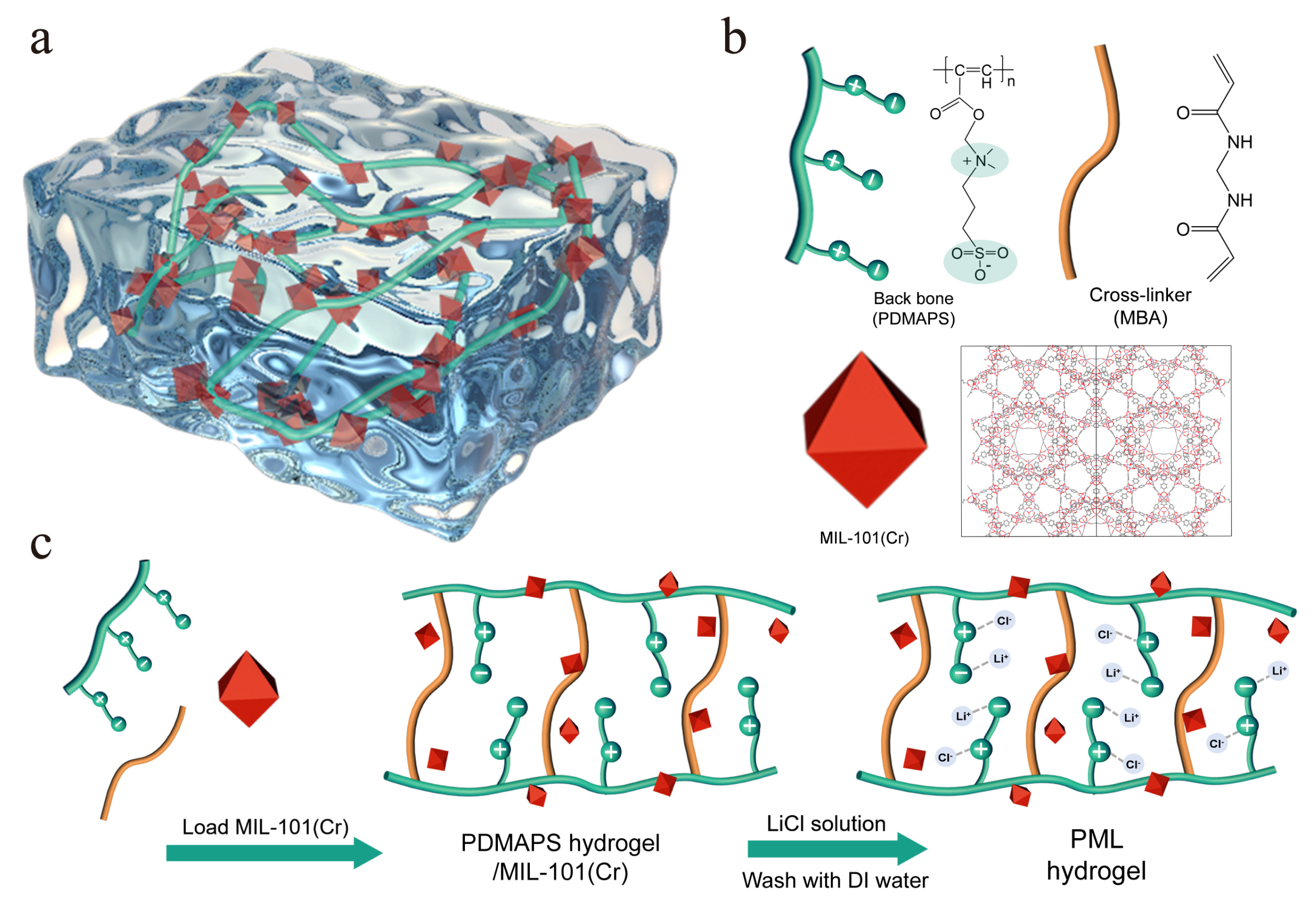

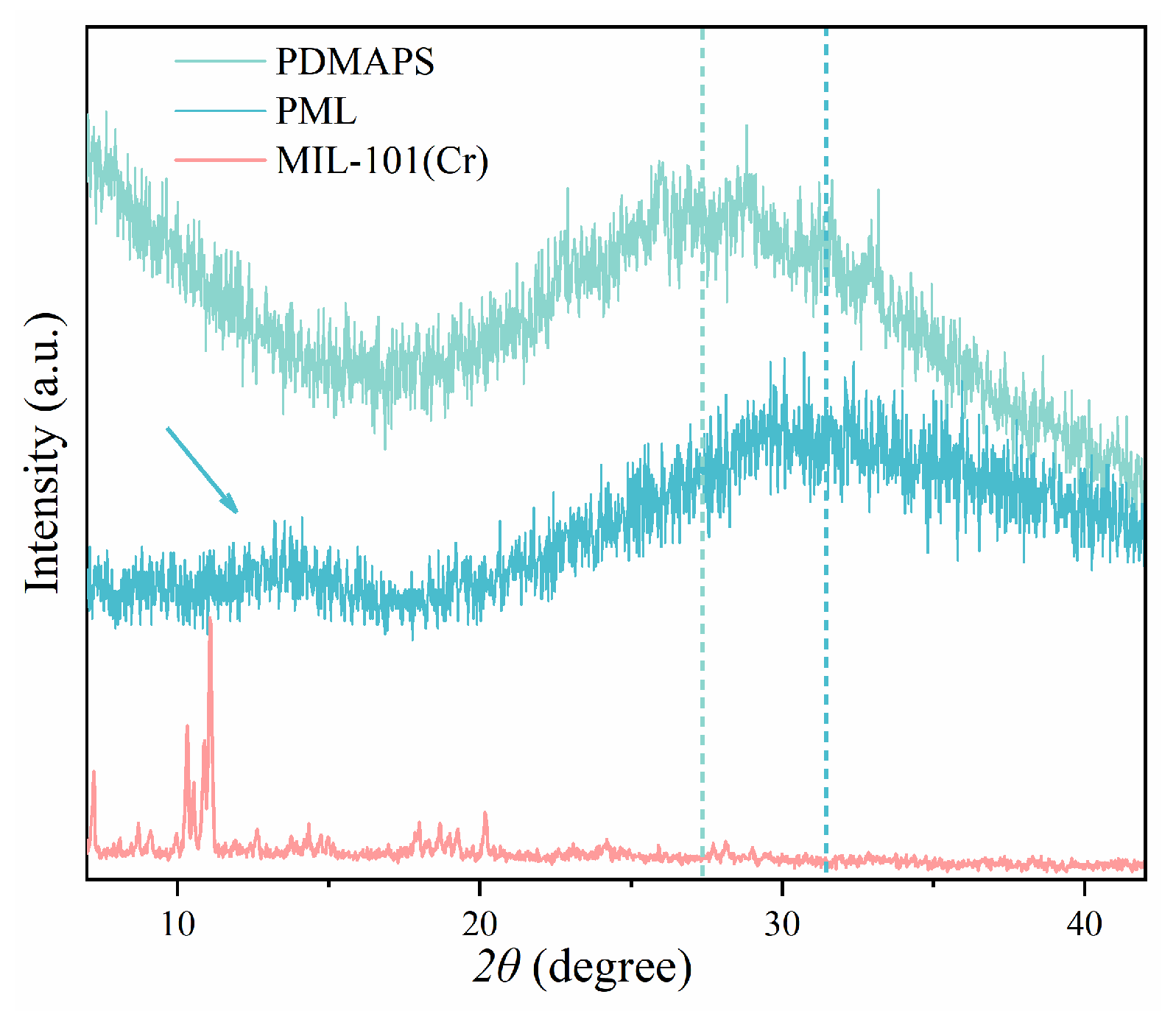
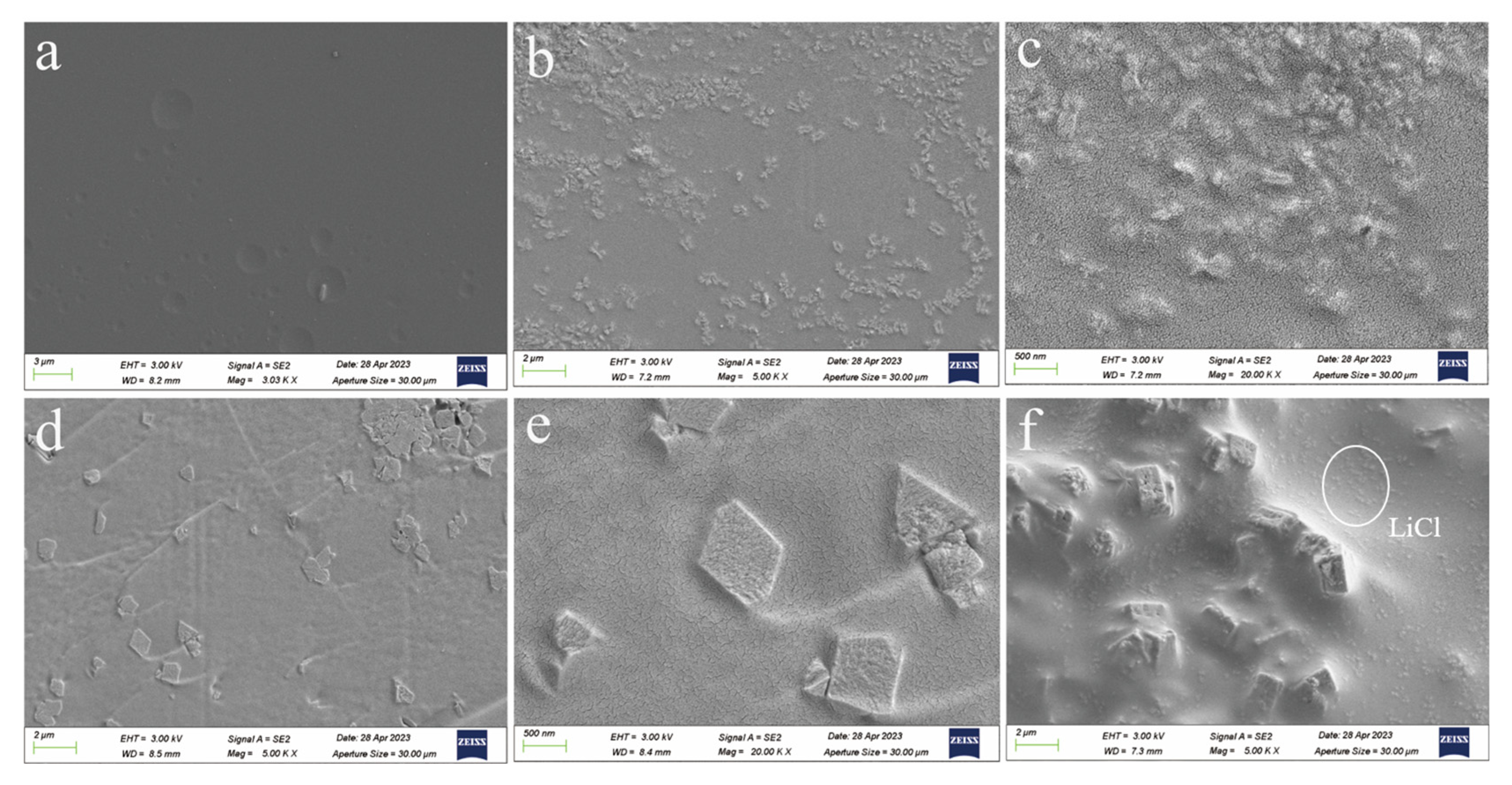
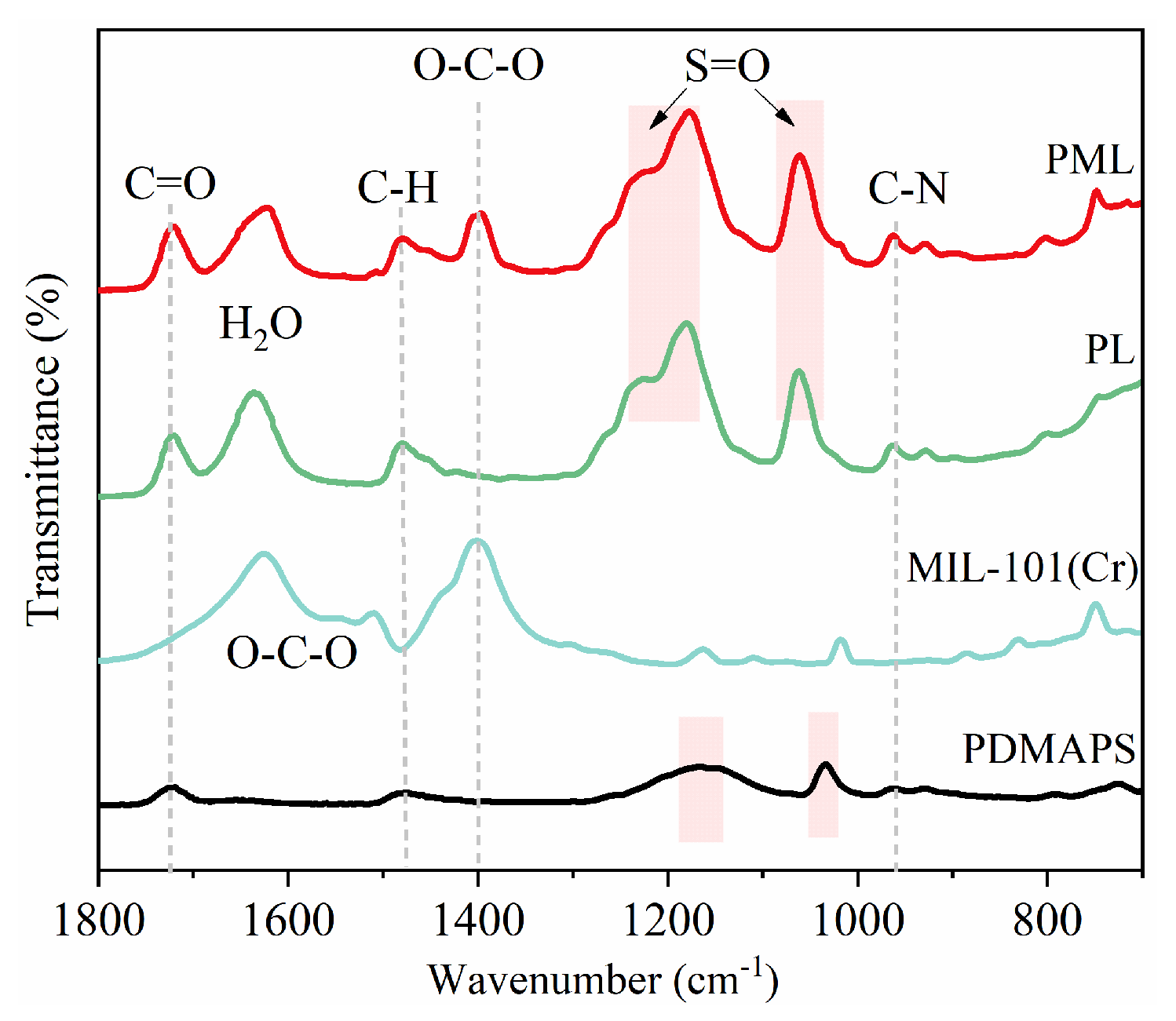

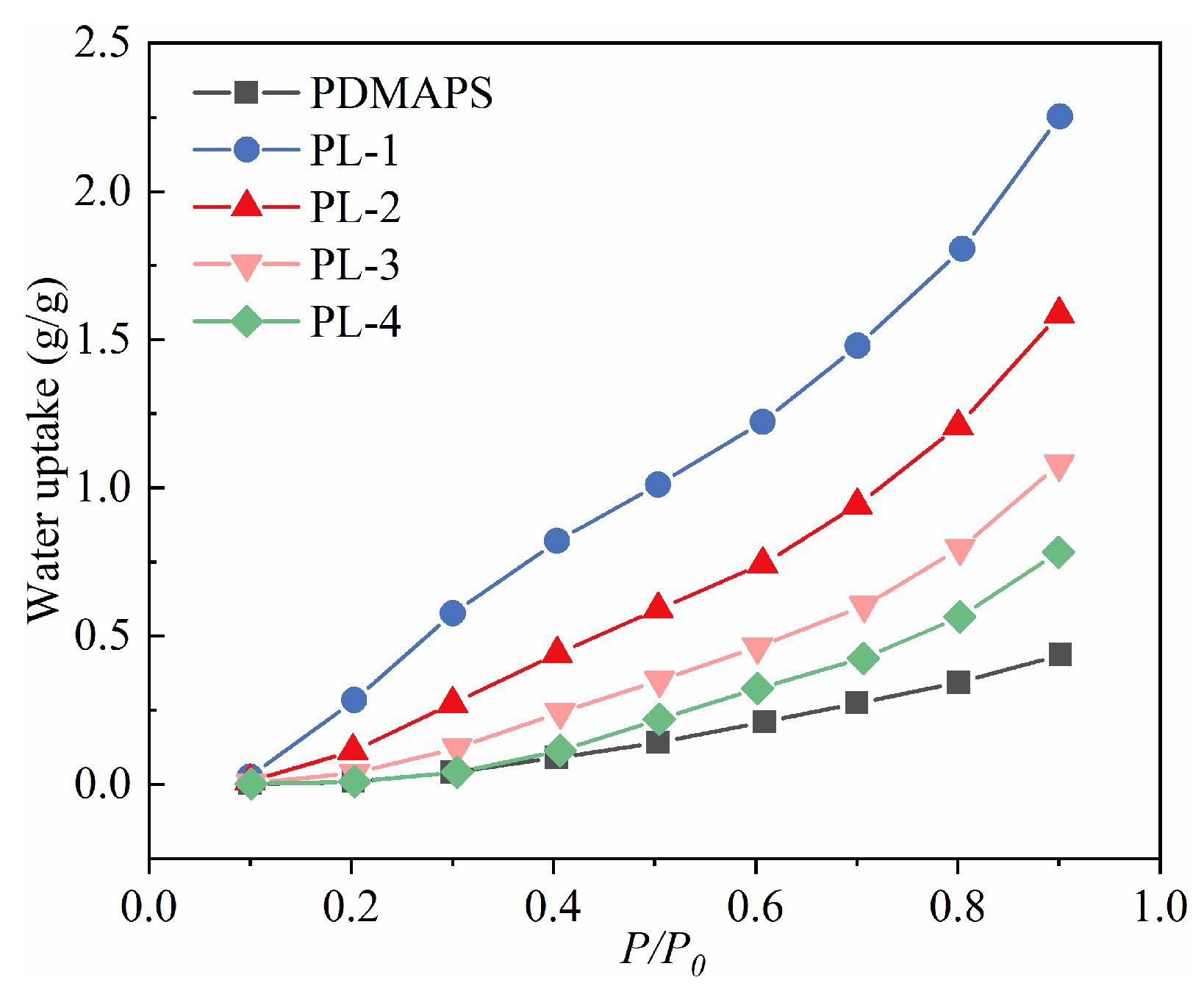
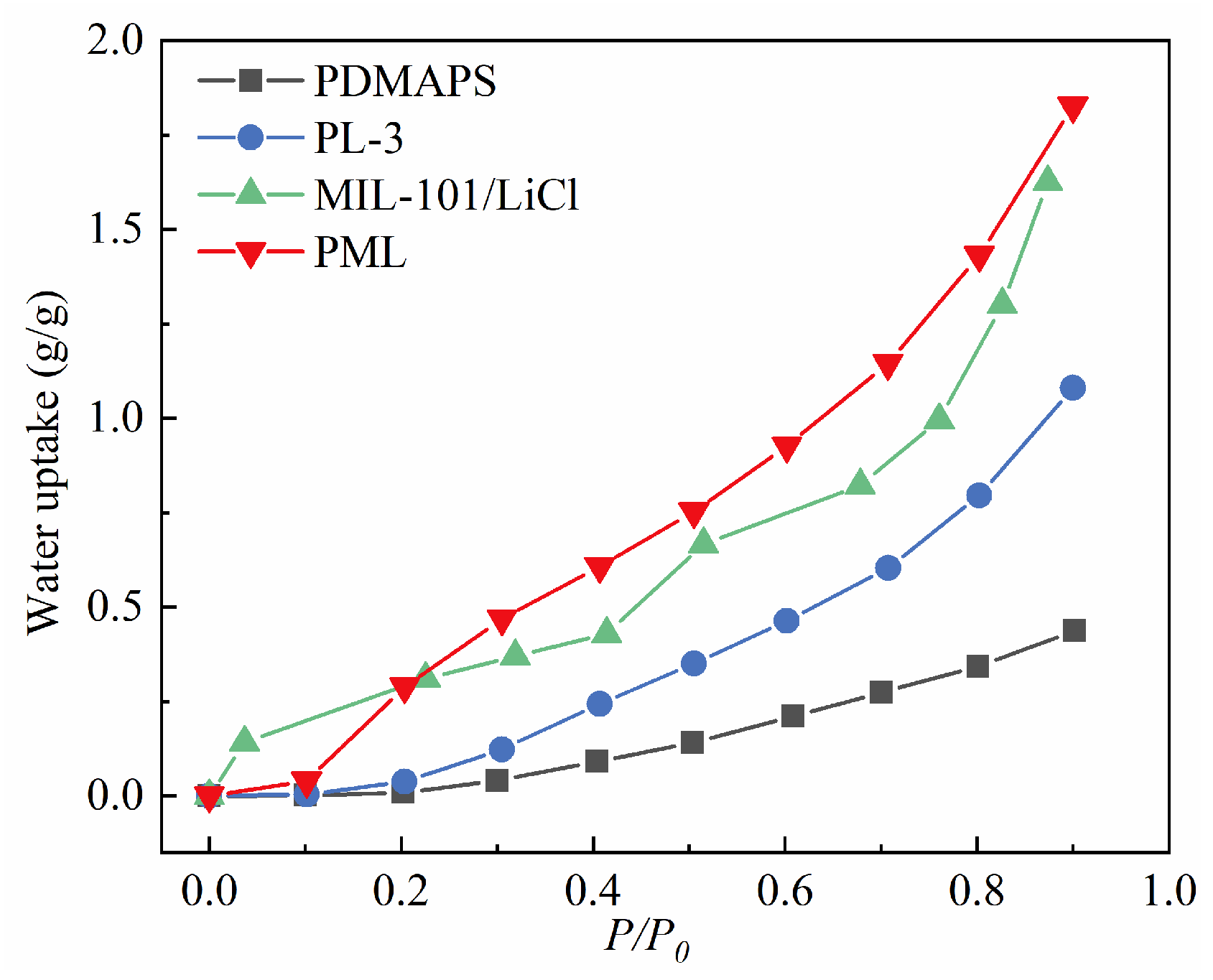
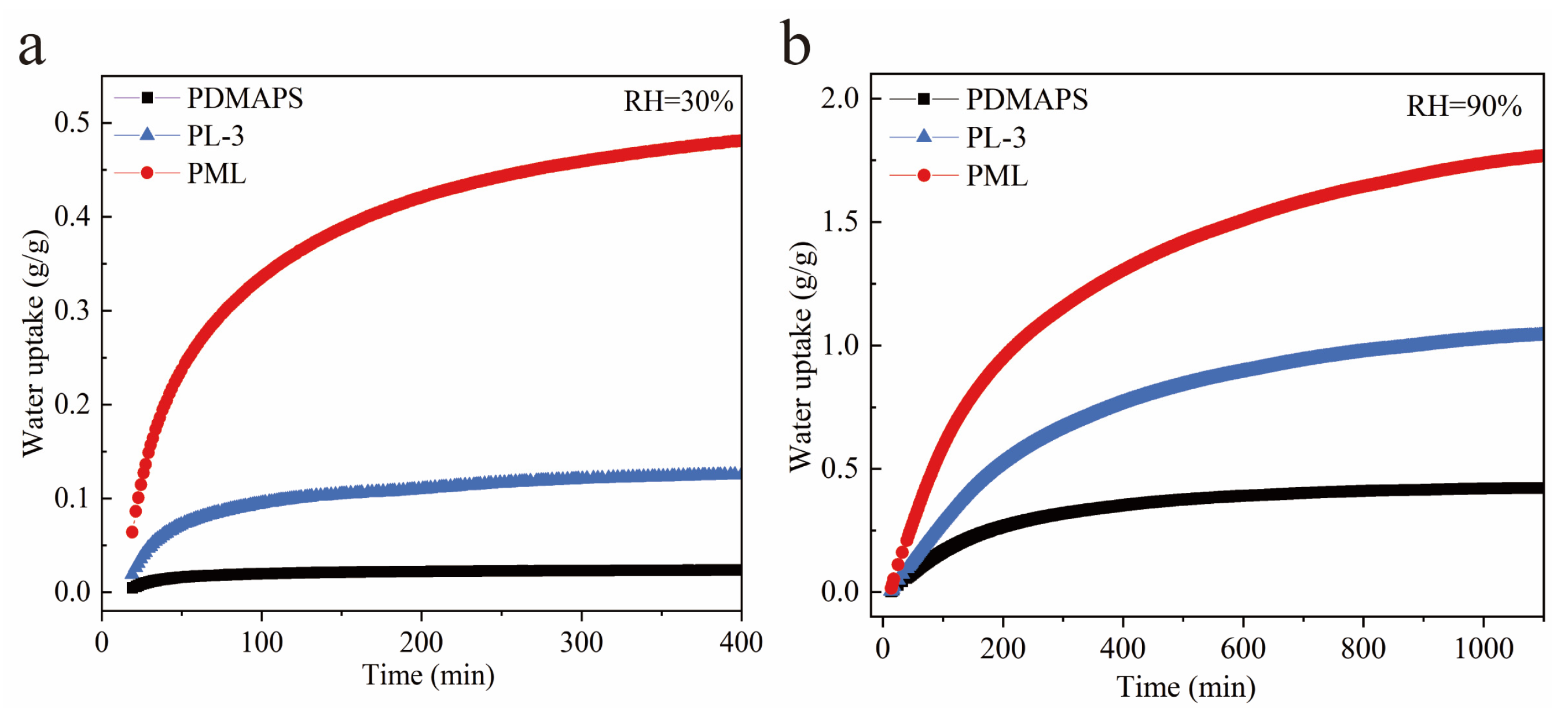
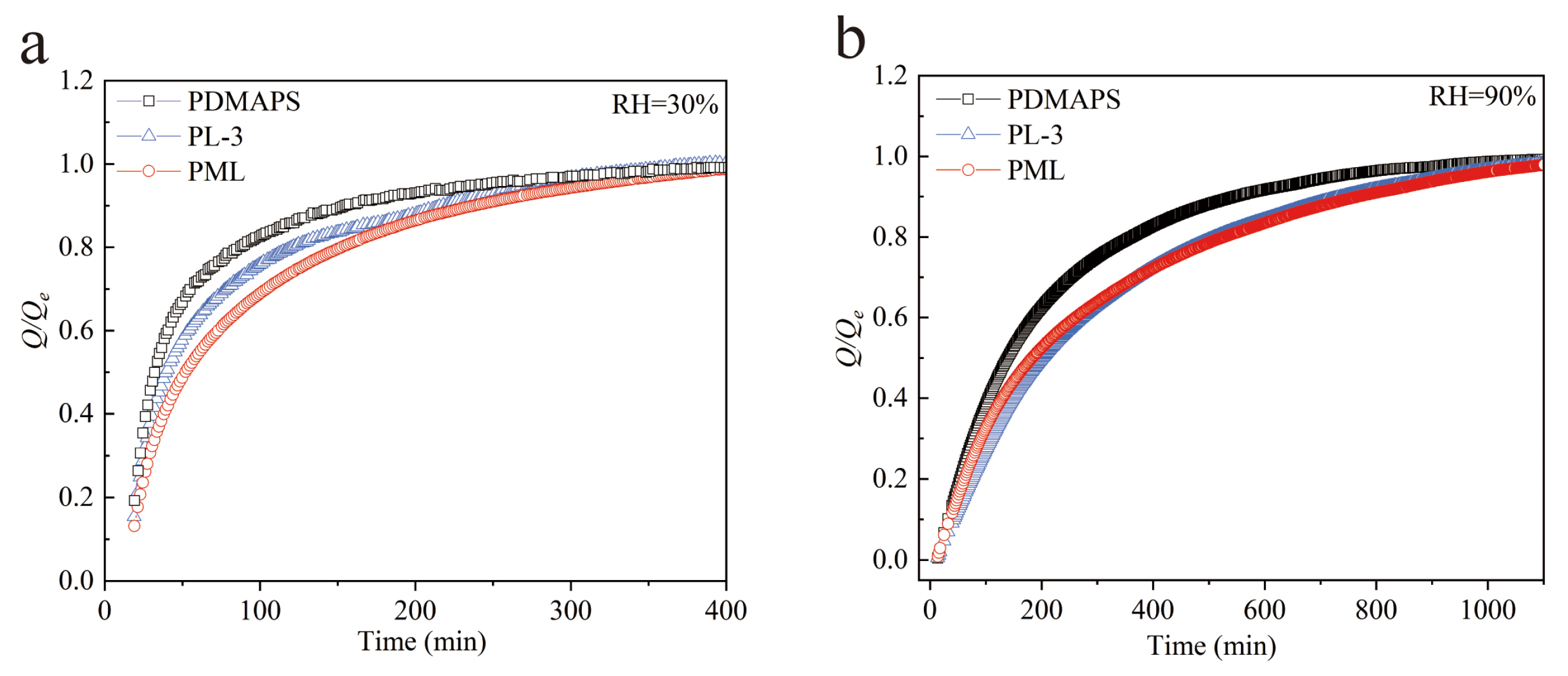


Disclaimer/Publisher’s Note: The statements, opinions and data contained in all publications are solely those of the individual author(s) and contributor(s) and not of MDPI and/or the editor(s). MDPI and/or the editor(s) disclaim responsibility for any injury to people or property resulting from any ideas, methods, instructions or products referred to in the content. |
© 2024 by the authors. Licensee MDPI, Basel, Switzerland. This article is an open access article distributed under the terms and conditions of the Creative Commons Attribution (CC BY) license (https://creativecommons.org/licenses/by/4.0/).
Share and Cite
Yan, J.; Li, W.; Yu, Y.; Huang, G.; Peng, J.; Lv, D.; Chen, X.; Wang, X.; Liu, Z. A Polyzwitterionic@MOF Hydrogel with Exceptionally High Water Vapor Uptake for Efficient Atmospheric Water Harvesting. Molecules 2024, 29, 1851. https://doi.org/10.3390/molecules29081851
Yan J, Li W, Yu Y, Huang G, Peng J, Lv D, Chen X, Wang X, Liu Z. A Polyzwitterionic@MOF Hydrogel with Exceptionally High Water Vapor Uptake for Efficient Atmospheric Water Harvesting. Molecules. 2024; 29(8):1851. https://doi.org/10.3390/molecules29081851
Chicago/Turabian StyleYan, Jian, Wenjia Li, Yingyin Yu, Guangyu Huang, Junjie Peng, Daofei Lv, Xin Chen, Xun Wang, and Zewei Liu. 2024. "A Polyzwitterionic@MOF Hydrogel with Exceptionally High Water Vapor Uptake for Efficient Atmospheric Water Harvesting" Molecules 29, no. 8: 1851. https://doi.org/10.3390/molecules29081851





